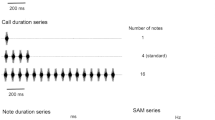Summary
We have recorded from single auditory nerve fibres in the lizard,Gekko gecko, while changing the animal's temperature within the range 19–30 °C. Small steps of 0.5–2 °C (as measured next to the otic capsule or within the contralateral inner ear) cause a small but reliable and reversible change in the tuning characteristics of a fibre: its tuning curve (frequency-threshold curve) shifts to higher frequencies with warming and lower frequencies with cooling (Figs. 1, 2 and 3). The sharpness of tuning and overall sensitivity of the fibres are relatively unaffected by these procedures. The mean shift in characteristic frequency (CF) for 34 fibres was 0.06 octaves per °C (Fig. 4A). A more accurate estimate is given by the mean shift in ‘centre frequency’: a point midway between the low-frequency and high-frequency sides of the tuning curve at 10 dB above CF threshold. This shift was 0.05 octaves per °C (Fig. 4B), which is equivalent to a thermalQ 10 of approximately 1.4 for the frequency change with temperature. Comparison of these results and analogous frequency shifts with temperature reported for other auditory organs suggests that tuning in the mammalian cochlea is less temperature-dependent than it is in nonmammalian inner ears; this may reflect a basic difference in how tuning is achieved. The observed temperature sensitivities are discussed in terms of what might be expected for tuning by basilar and/or tectorial membranes and for tuning of conductances within the hair cell membrane.
Similar content being viewed by others
Abbreviations
- CF :
-
characteristic frequency
References
Anderson CR, Stevens CF (1973) Voltage clamp analysis of acetylcholine produced end-plate current fluctuations at frog neuromuscular junction. J Physiol 235:655–691
Brey HB de, Eggermont JJ (1978) The influence of cochlear temperature on the electrical travelling wave pattern in the guinea pig cochlea. Acta Otolaryngol (Stockh) 85:363–371
Campbell HW (1969) The effects of temperature on the auditory sensitivity of lizards. Physiol Zool 42:183–210
Capranica RR, Moffat AJM (1976) Effects of anoxia on the response properties of auditory nerve fibres in the American toad. J Acoust Soc Am 59 Suppl 1: S46
Coats AC 1965) Temperature effects on the peripheral auditory apparatus. Science 150:1481–1483
Cole KS (1968) Membranes, ions and impulses. University of California Press, Berkeley Los Angeles
Crawford AC, Fettiplace R (1979) Reversal of hair cell responses by current. J Physiol 295: 66P
Eatock RA, Manley GA (1976) Temperature effects on single auditory nerve fibre responses. J Acoust Soc Am 60 Suppl 1: S80
Eatock RA, Manley GA, Pawson L (1981) Auditory nerve fibre activity in the Tokay gecko. I. Implications for cochlear processing. J Comp Physiol 142:203–218
Fettiplace R, Crawford AC (1978) The coding of sound pressure and frequency in cochlear hair cells of the terrapin. Proc R Soc Lond [Biol] 203:209–218
Frankenhaeuser B, Moore LE (1963) The effect of temperature on the sodium and potassium permeability changes in myelinated nerve fibres ofXenopus laevis. J Physiol 169:431–437
Guttman R (1969) Temperature dependence of oscillatory behavior of squid axons. Biophys J 9:269–277
Hodgkin AL, Huxley AF (1952) A quantitative description of membrane current and its application to conduction and excitation in nerve. J Physiol 117:500–544
Hopkins CD (1976) Stimulus filtering and electroreception: tuberous electroreceptors in three species of gymnotoid fish. J Comp Physiol 111:171–207
Jack JJB, Noble D, Tsien RW (1975) Electric current flow in excitable cells. Oxford University Press, London
Manley GA (1972) Frequency response of the ear of the Tokay gecko. J Exp Zool 181:159–168
Manley JA, Johnstone BM (1974) A comparison of cochlear summating potentials in the bat and guinea pig, including temperature effects. J Comp Physiol 88:43–66
McCrum NG (1977) The molecular conformation of elastin as derived from mechanical investigations. In: Sandberg LB, Gray WR, Franzblau C (eds) Elastin and elastic tissues. Plenum, New York, pp 633–543
Moffat AJM, Capranica RR (1976) Effects of temperature on the response properties of auditory nerve fibers in the American toad (Bufo americanus). J Acoust Soc Am 60 Suppl 1:580
Necker R (1970) Zur Entstehung der Cochleapotentiale von Vögeln: Verhalten bei O2-Mangel, Cyanidvergiftung und Unterkühlung sowie Beobachtungen über die räumliche Verteilung. Z Vergl Physiol 69:367–425
Russell U, Sellick PM (1978) Intracellular studies of hair cells in the mammalian cochlea. J Physiol 284:261–290
Smolders J, Klinke R (1977) Effect of temperature changes on tuning properties of primary auditory fibres in caiman and cat. In: Portmann M, Aran J-M (eds) Inner ear biology. Les colloques de l'institut nationale de la santé et de la recherche médicale. 68: p 125. INSERM, Paris
Werner YL (1972) Temperature effects on inner-ear sensitivity in six species of iguanid lizards. J Herpetol 6:147–177
Werner YL (1976) Optimal temperatures for inner-ear performance in gekkonid lizards. J Exp Zool 195:319–352
Author information
Authors and Affiliations
Additional information
This work constitutes partial fulfillment of the requirements for the M.Sc. degree of R.A.E.
Special thanks are due to D.P. Corey for invaluable discussions and advice. We also thank D.C. Van Essen for comments on the manuscript. This work was supported by grants from the National Research Council of Canada and the Québec Dept. of Education.
Rights and permissions
About this article
Cite this article
Eatock, R.A., Manley, G.A. Auditory nerve fibre activity in the Tokay gecko. J. Comp. Physiol. 142, 219–226 (1981). https://doi.org/10.1007/BF00605740
Accepted:
Issue Date:
DOI: https://doi.org/10.1007/BF00605740




